Nasa halla dos planetas del tamaño de la Tierra (+Fotos)
2 participantes
MUNDOALERTA . LAS NOTICIAS MAS DESTACADAS DEL MUNDO :: NOTICIAS RELACIONADAS CON EL COSMOS :: Actualidad de eventos exteriores a nuestro Sistema Solar. (Galaxia/s, Estrellas, ...)
Página 1 de 1.
 Nasa halla dos planetas del tamaño de la Tierra (+Fotos)
Nasa halla dos planetas del tamaño de la Tierra (+Fotos)
Estimados colegasd para su conocimiento:
 Foto:EFE/Nasa
Foto:EFE/Nasa
Washington, 20 dic (EFE).- Los astrónomos de la misión Kepler en la Nasa anunciaron hoy que detectaron dos planetas del tamaño de la Tierra y que orbitan una estrella distante, lo que calificaron como “un hito en la búsqueda de mundos extraterrestres”.
“Después de casi tres años, el observatorio orbital Kepler ha confirmado la existencia de planetas que orbitan estrellas”, dijo en una conferencia telefónica Nick Gautier, del Laboratorio de Propulsión de la Nasa en Pasadena, California (EE.UU.).
Los dos planetas, bautizados Kepler-20e y 20f, son los más pequeños hallados hasta ahora en una órbita en torno a una estrella fuera de nuestro sistema solar y uno de ellos tiene un diámetro un 3 % menor que el de la Tierra, mientras que el otro es un 3 % mayor.
Ambos orbitan la estrella Kepler-20, un astro de tipo G levemente más frío que el Sol y ubicado a casi mil años luz de la Tierra, señalaron los científicos.
 Foto: EFE/Nasa
Foto: EFE/Nasa
Los investigadores creen que estos planetas tienen una composición rocosa, de manera que sus masas deben de ser entre 2,7 menos y 3 veces más que la masa de la Tierra.
David Charbonneau, profesor de astronomía en la Universidad Harvard, explicó que, en realidad, los astrónomos han encontrado cinco planetas.
“En nuestro sistema solar hay ocho planetas rocosos, ubicados más cerca del sol, y otros más gaseosos, ubicados más lejos”, explicó. “En el sistema de la Kepler-20 los planetas están alegremente mezclados: el primero que se encuentra es parecido a Neptuno, el siguiente es rocoso, el siguiente Neptuno, el otro rocoso… uno grande y uno chico, uno grande y uno chico, uno grande… y todos orbitan dentro de la distancia que Mercurio orbita al Sol”.
 Foto: EFE/Nasa
Foto: EFE/NasaFuente:
[Tienes que estar registrado y conectado para ver este vínculo]
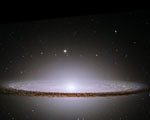
OMACHIN- Reportero total

 Re: Nasa halla dos planetas del tamaño de la Tierra (+Fotos)
Re: Nasa halla dos planetas del tamaño de la Tierra (+Fotos)
 | Min: 22° C | Max: 33° C Panamá, Ciudad de Panamá jueves, 26 de enero de 2012 |
| | |
| |
Con la tecnología de  Traductor de Google
Traductor de Google
 Traductor de Google
Traductor de Googlelaestrella.com.pa
| Noticias
| Ciencia y Tecnología
Telescopio Kepler de la NASA confirma 26 nuevos exoplanetas
AFP
[Tienes que estar registrado y conectado para ver este vínculo]
¡Síguenos en Twitter!
@EstrellaOnline
 |
| FOTO: AFP / ILUSTRATIVA |
2012-01-26 — 6:38:00 PM —
El telescopio espacial Kepler confirmó la existencia de 26 nuevos
planetas fuera de nuestro sistema solar (exoplanetas) todos ellos
orbitando demasiado cerca de sus estrellas para albergar vida, dijo este
jueves la agencia espacial estadounidense (NASA).
Dispersos a
través de 11 sistemas planetarios, sus temperaturas serían demasiado
altas para la supervivencia, ya que todos orbitan sus estrellas más
cerca que Venus, el segundo planeta desde el Sol, que tiene una
temperatura en la superficie de 464 grados Celsius.
Pero los
científicos de la NASA se mostraron satisfechos con el descubrimiento,
que casi dobla el número de exoplanetas confirmados que Kepler ha
encontrado desde 2009.
"Antes de la misión Kepler, sabíamos de
quizás unos 500 exoplanetas a través de todo el cielo", dijo Doug
Hudgins, científico del programa Kepler en la sede de la NASA.
"Ahora, en sólo dos años mirando a un trozo de cielo no mayor que el
puño, Kepler ha descubierto más de 60 planetas y más de 2.300 candidatos
a planeta", agregó.
"Esto nos dice que nuestra galaxia está definitivamente cargada de planetas de todos los tamaños y órbitas.
"Los hallazgos se describen en cuatro trabajos distintos publicados en
las revistas Astrophysical Journal y Monthly Notices de la Royal
Astronomical Society, dijo la NASA en un comunicado.
Lanzada
en marzo de 2009, la sonda Kepler tiene por misión observar más de
100.000 estrellas parecidas al Sol con el fin de encontrar planetas
hermanos de la Tierra donde podría haber vida.

lilian- Moderador Global

 Nuevas observaciones de materia interestelar...
Nuevas observaciones de materia interestelar...
Nave de la NASA revela nuevas observaciones de la materia interestelar
WASHINGTON
- El Explorador del Límite Interestelar de la NASA (IBEX) ha capturado
la visión mejor y más completo hasta ahora de lo que está más allá del
sistema solar. Las
nuevas medidas dan pistas sobre cómo y dónde se formó nuestro sistema
solar, las fuerzas que físicamente forma nuestro sistema solar, y la
historia de otras estrellas en la Vía Láctea.
La nave espacial que orbita la Tierra observado cuatro tipos diferentes de átomos como el hidrógeno, oxígeno, neón y helio. Estos
átomos interestelares son los subproductos de las estrellas más viejas,
que se extendió por toda la galaxia y llenar el gran espacio entre las
estrellas. IBEX
decidió la distribución de estos elementos fuera del sistema solar, que
fluyen cargadas y partículas neutras que soplan a través de la galaxia,
o el viento interestelar llamada.
"IBEX
es una misión del Explorador de pequeño y fue construido con una
modesta inversión", dijo Barbara Giles, director de la División de
Heliofísica de la NASA en Washington. "Los
logros de la ciencia, aunque han sido verdaderamente notable y son un
testimonio de lo que puede lograrse cuando nos dan a los científicos de
nuestro país la libertad de innovar."
En
una serie de artículos científicos que aparecen en el Diario
Astrofísico el 31 de enero, informan los científicos encontrar 74 átomos
de oxígeno por cada 20 átomos de neón con el viento interestelar. En nuestro propio sistema solar, hay 111 átomos de oxígeno por cada 20 átomos de neón. Esto se traduce en mayor cantidad de oxígeno en cualquier parte del sistema solar que en el espacio interestelar cercano.
"Nuestro
sistema solar es diferente que el espacio de la derecha fuera de ella,
lo que sugiere dos posibilidades", dijo David McComas, investigador
principal de IBEX, en el Instituto de Investigación del Suroeste en San
Antonio. "O
bien el sistema solar se desarrolló en una sección aparte, más rica en
oxígeno de la galaxia de donde residen actualmente, o una gran cantidad
de críticas, que da vida el oxígeno se encuentra atrapado en granos de
polvo interestelar o helados, incapaces de moverse libremente por el
espacio . "
Los nuevos resultados encerrar pistas sobre la historia de la materia en el universo. Mientras
que el Big Bang creó inicialmente el hidrógeno y el helio, sólo las
explosiones de supernovas al final de la vida de una estrella se puede
propagar los elementos más pesados del oxígeno y neón por la galaxia. Conocer
la cantidad de elementos en el espacio puede ayudar a mapear los
científicos cómo nuestra galaxia evolucionado y cambiado con el tiempo.
Los
científicos quieren comprender la composición de la región de la
frontera que separa el más cercano llega de nuestra galaxia, llamado el
medio interestelar local, de nuestra heliosfera. La
heliosfera actúa como una burbuja protectora que protege nuestro
sistema solar a partir de la mayor parte de la peligrosa radiación
cósmica galáctica que de otra manera entrar en el sistema solar desde el
espacio interestelar.
IBEX
mide el viento interestelar a una velocidad más lenta de lo que se mide
por la nave espacial Ulises, y desde una dirección diferente. Las
medidas de mejora del IBEX muestran una diferencia del 20 por ciento en
la cantidad de presión que ejerce el viento interestelar de nuestra
heliosfera.
"La
medición de la presión sobre nuestra heliosfera del material de la
galaxia y de los campos magnéticos que hay que ayudar a determinar el
tamaño y la forma de nuestro sistema solar a medida que viaja a través
de la galaxia", dice Eric Christian, científico de IBEX misión, en el
Centro Goddard de la NASA Centro de Vuelo Espacial en Greenbelt, Maryland
La nave espacial IBEX fue lanzada en octubre de 2008. Su
objetivo es descubrir la ciencia de la naturaleza de las interacciones
entre el viento solar y el medio interestelar en el borde de nuestro
sistema solar.
El Southwest Research Institute desarrolló y dirige la misión IBEX con un equipo de colaboradores nacionales e internacionales. La
nave es una de las series de la NASA de bajo costo, las misiones se
desarrolló rápidamente en el Programa de Pequeños Exploradores. Goddard dirige el programa de Dirección de la agencia de Misiones Científicas de la NASA en Washington.
Para más información sobre IBEX, visite:
WASHINGTON
- El Explorador del Límite Interestelar de la NASA (IBEX) ha capturado
la visión mejor y más completo hasta ahora de lo que está más allá del
sistema solar. Las
nuevas medidas dan pistas sobre cómo y dónde se formó nuestro sistema
solar, las fuerzas que físicamente forma nuestro sistema solar, y la
historia de otras estrellas en la Vía Láctea.
La nave espacial que orbita la Tierra observado cuatro tipos diferentes de átomos como el hidrógeno, oxígeno, neón y helio. Estos
átomos interestelares son los subproductos de las estrellas más viejas,
que se extendió por toda la galaxia y llenar el gran espacio entre las
estrellas. IBEX
decidió la distribución de estos elementos fuera del sistema solar, que
fluyen cargadas y partículas neutras que soplan a través de la galaxia,
o el viento interestelar llamada.
"IBEX
es una misión del Explorador de pequeño y fue construido con una
modesta inversión", dijo Barbara Giles, director de la División de
Heliofísica de la NASA en Washington. "Los
logros de la ciencia, aunque han sido verdaderamente notable y son un
testimonio de lo que puede lograrse cuando nos dan a los científicos de
nuestro país la libertad de innovar."
En
una serie de artículos científicos que aparecen en el Diario
Astrofísico el 31 de enero, informan los científicos encontrar 74 átomos
de oxígeno por cada 20 átomos de neón con el viento interestelar. En nuestro propio sistema solar, hay 111 átomos de oxígeno por cada 20 átomos de neón. Esto se traduce en mayor cantidad de oxígeno en cualquier parte del sistema solar que en el espacio interestelar cercano.
"Nuestro
sistema solar es diferente que el espacio de la derecha fuera de ella,
lo que sugiere dos posibilidades", dijo David McComas, investigador
principal de IBEX, en el Instituto de Investigación del Suroeste en San
Antonio. "O
bien el sistema solar se desarrolló en una sección aparte, más rica en
oxígeno de la galaxia de donde residen actualmente, o una gran cantidad
de críticas, que da vida el oxígeno se encuentra atrapado en granos de
polvo interestelar o helados, incapaces de moverse libremente por el
espacio . "
Los nuevos resultados encerrar pistas sobre la historia de la materia en el universo. Mientras
que el Big Bang creó inicialmente el hidrógeno y el helio, sólo las
explosiones de supernovas al final de la vida de una estrella se puede
propagar los elementos más pesados del oxígeno y neón por la galaxia. Conocer
la cantidad de elementos en el espacio puede ayudar a mapear los
científicos cómo nuestra galaxia evolucionado y cambiado con el tiempo.
Los
científicos quieren comprender la composición de la región de la
frontera que separa el más cercano llega de nuestra galaxia, llamado el
medio interestelar local, de nuestra heliosfera. La
heliosfera actúa como una burbuja protectora que protege nuestro
sistema solar a partir de la mayor parte de la peligrosa radiación
cósmica galáctica que de otra manera entrar en el sistema solar desde el
espacio interestelar.
IBEX
mide el viento interestelar a una velocidad más lenta de lo que se mide
por la nave espacial Ulises, y desde una dirección diferente. Las
medidas de mejora del IBEX muestran una diferencia del 20 por ciento en
la cantidad de presión que ejerce el viento interestelar de nuestra
heliosfera.
"La
medición de la presión sobre nuestra heliosfera del material de la
galaxia y de los campos magnéticos que hay que ayudar a determinar el
tamaño y la forma de nuestro sistema solar a medida que viaja a través
de la galaxia", dice Eric Christian, científico de IBEX misión, en el
Centro Goddard de la NASA Centro de Vuelo Espacial en Greenbelt, Maryland
La nave espacial IBEX fue lanzada en octubre de 2008. Su
objetivo es descubrir la ciencia de la naturaleza de las interacciones
entre el viento solar y el medio interestelar en el borde de nuestro
sistema solar.
El Southwest Research Institute desarrolló y dirige la misión IBEX con un equipo de colaboradores nacionales e internacionales. La
nave es una de las series de la NASA de bajo costo, las misiones se
desarrolló rápidamente en el Programa de Pequeños Exploradores. Goddard dirige el programa de Dirección de la agencia de Misiones Científicas de la NASA en Washington.
Para más información sobre IBEX, visite:
| r | | Next Animation Number |
| NASA's IBEX Spacecraft Reveals New Observations of Interstellar Matter | |||||||||||||||||||||||||||||||||||||||||
A great magnetic bubble surrounds the solar system as it cruises through the galaxy. The sun pumps the inside of the bubble full of solar particles that stream out to the edge until they collide with the material that fills the rest of the galaxy, at a complex boundary called the heliosheath. On the other side of the boundary, electrically charged particles from the galactic wind blow by, but rebound off the heliosheath, never to enter the solar system. Neutral particles, on the other hand, are a different story. They saunter across the boundary as if it weren't there, continuing on another 7.5 billion miles for 30 years until they get caught by the sun's gravity, and sling shot around the star. There, NASA's Interstellar Boundary Explorer lies in wait for them. Known as IBEX for short, this spacecraft methodically measures these samples of the mysterious neighborhood beyond our home. IBEX scans the entire sky once a year, and every February, its instruments point in the correct direction to intercept incoming neutral atoms. IBEX counted those atoms in 2009 and 2010 and has now captured the best and most complete glimpse of the material that lies so far outside our own system. The results? It's an alien environment out there: the material in that galactic wind doesn't look like the same stuff our solar system is made of. More than just helping to determine the distribution of elements in the galactic wind, these new measurements give clues about how and where our solar system formed, the forces that physically shape our solar system, and even the history of other stars in the Milky Way. In a series of science papers appearing in the Astrophysics Journal on January 31, 2012, scientists report that for every 20 neon atoms in the galactic wind, there are 74 oxygen atoms. In our own solar system, however, for every 20 neon atoms there are 111 oxygen atoms. That translates to more oxygen in any given slice of the solar system than in the local interstellar space. For media associated with this release, go: here,and here. | |||||||||||||||||||||||||||||||||||||||||
| Share: [email=?subject=Something%20to%20share%20on%20NASA/Goddard%27s%20Scientific%20Visualization%20Studio%20Web%20site&body=http://svs.gsfc.nasa.gov/goto?10906]  E-mail[/email] E-mail[/email]  Twitter Twitter | |||||||||||||||||||||||||||||||||||||||||
| Other multimedia items related to this story: | |||||||||||||||||||||||||||||||||||||||||
| The Local Interstellar Wind as Seen by IBEX (id 3900) | |||||||||||||||||||||||||||||||||||||||||
| Interstellar Neutral Atoms (id 10905) | |||||||||||||||||||||||||||||||||||||||||
| Interstellar Boundry Explorer (IBEX) (id 20131) | |||||||||||||||||||||||||||||||||||||||||
| | |||||||||||||||||||||||||||||||||||||||||
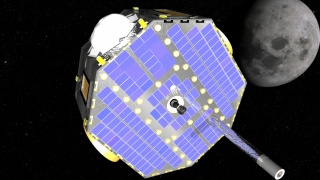 | | Short, narrated video about IBEX's interstellar matter observations.For complete transcript, click here. Duration: 3.0 minutes Available formats: 1280x720 (59.94 fps) QT 2 GB 1280x720 (59.94 fps) QT 788 MB 1280x720 (29.97 fps) QT 151 MB 960x720 (29.97 fps) MPEG-4 107 MB 1280x720 (29.97 fps) WMV 85 MB 1280x720 (30 fps) QT 80 MB 1280x720 (29.97 fps) MPEG-4 58 MB 1280x720 (59.94 fps) QT 43 MB 640x360 (29.97 fps) MPEG-4 36 MB 320x180 (29.97 fps) MPEG-4 14 MB 1280x720 PNG 1 MB 320x180 PNG 250 KB How to play our movies | |||||||||||||||||||||||||||||||||||||||
| | |||||||||||||||||||||||||||||||||||||||||
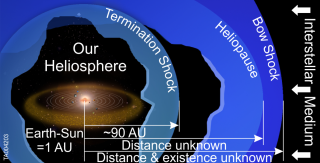 | | Our heliosphere is the region of space dominated by the Sun and is inflated, like a bubble, in local interstellar material by the million mile-per-hour solar wind. This bubble keeps out the ionized or charged particles and magnetic fields from the galaxy and so protects us from dangerous Galactic Cosmic Rays. Credit: SwRI Available formats: 1035 x 530 TIFF 2 MB 1035 x 530 JPEG 433 KB 320 x 163 PNG 218 KB | |||||||||||||||||||||||||||||||||||||||
| | |||||||||||||||||||||||||||||||||||||||||
 | | A face-on view of our Milky Way Galaxy begins the animation. The Milky Way Galaxy is organized into spiral arms of giant stars that illuminate interstellar gas and dust. The Sun is in a finger called the Orion Spur. A zoom to the cluster of tenuous interstellar clouds close to the Sun reveals the cloud motions. The final zoom reveals that the Sun will soon emerge from the Local Cloud that now surrounds the Sun.Credit: NASA/Adler/U. Chicago/Wesleyan/JPL-Caltech Duration: 44.3 seconds Available formats: 1920x1080 (30 fps) QT 689 MB 1920x1080 (30 fps) QT 69 MB 1920x1080 (30 fps) QT 22 MB 1920x1080 (29.97 fps) QT 18 MB 1920x1080 (29.97 fps) MPEG-4 16 MB 1280x720 (29.97 fps) WMV 14 MB 960x720 (29.97 fps) MPEG-4 14 MB 1920x1080 (29.97 fps) QT 10 MB 640x360 (29.97 fps) MPEG-4 7 MB 320x180 (29.97 fps) MPEG-4 2 MB 1920x1080 JPEG 596 KB 320x180 PNG 101 KB How to play our movies | |||||||||||||||||||||||||||||||||||||||
| | |||||||||||||||||||||||||||||||||||||||||
 | | The Orion nebula is a stellar nursery. Giant interstellar clouds cradle massive young stars that are only a few hundred thousands years old. The brilliant whitish core is illuminated by the young Trapezium stars. Remnants of the star-forming dust cocoon are seen as dark lanes against a bright adjacent nebula. Towards the right of the region, interstellar gas and dust have been blown into giant arcs and bubbles by strong stellar winds. Giant bubbles of interstellar gas, formed from stellar winds and supernovae, are found throughout space, including close to the Sun.Credit: NASA/Hubble Available formats: 1280 x 720 TIFF 2 MB 1280 x 720 JPEG 885 KB 320 x 180 PNG 331 KB | |||||||||||||||||||||||||||||||||||||||
| | |||||||||||||||||||||||||||||||||||||||||
 | | Located in the constellation of Taurus, the Crab nebula is the remnant of a supernova formed from the explosion of a massive star a thousand years ago in 1054. Most elements on Earth are produced by supernova explosions. About thirty elements in the periodic chart have been detected in the interstellar medium. Supernova such as the Crab have produced the interstellar oxygen and neon atoms that are observed by IBEX.Credit: NASA/ESA Available formats: 1280 x 720 TIFF 2 MB 1280 x 720 JPEG 408 KB 320 x 180 PNG 253 KB | |||||||||||||||||||||||||||||||||||||||
| | |||||||||||||||||||||||||||||||||||||||||
 | | If we had the privilege to look up at the sky far away from the Sun using Giordi LaForge's visor we would see the interstellar wind "beckoning" at us as a bright spotlight from the direction of Scorpio. Shown are Sagittarius, Scorpio, and Libra, as seen, for example, when looking south at midnight in June, with the interstellar wind above Scorpio. Available formats: 1280 x 720 TIFF 2 MB 320 x 180 PNG 302 KB 1280 x 720 JPEG 924 KB | |||||||||||||||||||||||||||||||||||||||
| | |||||||||||||||||||||||||||||||||||||||||
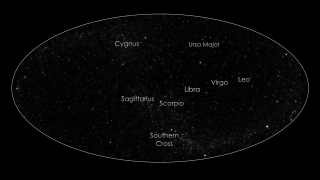 | | Animation, zooming out from Scorpio to a full sky view of the stars. It blends over to a color-coded full sky neutral atom map, as obtained with IBEX at energies where the interstellar wind is the brightest feature in the maps. In Earth's orbit, where IBEX makes its observations, the maximum flow (in red) is seen to arrive from Libra instead of Scorpio because the interstellar wind is forced to curve around the Sun by gravity. Credit: NASA/GSFC/UNH Duration: 15.0 seconds Available formats: 1280x720 (59.94 fps) QT 255 MB 1280x720 (59.94 fps) QT 33 MB 1280x720 (30 fps) QT 8 MB 960x720 (29.97 fps) MPEG-4 5 MB 1280x720 (29.97 fps) QT 4 MB 1280x720 (29.97 fps) MPEG-4 4 MB 1280x720 (59.94 fps) QT 4 MB 1280x720 (29.97 fps) WMV 3 MB 640x360 (29.97 fps) MPEG-4 2 MB 320x180 (29.97 fps) MPEG-4 864 KB 1280x720 JPEG 500 KB 320x180 PNG 135 KB How to play our movies | |||||||||||||||||||||||||||||||||||||||
| | |||||||||||||||||||||||||||||||||||||||||
 | | Still from previous visualization: color-coded full sky neutral atom map, as obtained with IBEX at energies where the interstellar wind is the brightest feature in the maps. In Earth's orbit, where IBEX makes its observations, the maximum flow (in red) is seen to arrive from Libra instead of Scorpio because the interstellar wind is forced to curve around the Sun by gravity. Credit: NASA/GSFC/UNH Available formats: 1280 x 720 TIFF 1 MB 1280 x 720 JPEG 268 KB 320 x 180 PNG 126 KB | |||||||||||||||||||||||||||||||||||||||
| | |||||||||||||||||||||||||||||||||||||||||
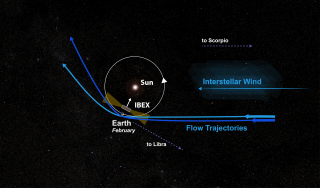 | | Pictorial view of the Earth's orbit and the interstellar flow, as seen from far above the North Pole. During its journey through the Sun's gravitation, the wind is bent like a soccer ball that is pulled back to Earth in a curve. Slower wind (dark blue) is bent stronger than faster wind. Thus, IBEX observes slower wind earlier on Earth's orbit than faster wind, during the month of February when the Earth moves into the flow. To determine the flow speed, the IBEX team has taken advantage of this "speedometer" that Mother Nature provides to us for free. Credit: NASA/GSFC/UNH Available formats: 5334 x 3134 TIFF 47 MB 10667 x 6268 JPEG 3 MB 320 x 188 PNG 296 KB | |||||||||||||||||||||||||||||||||||||||
| | |||||||||||||||||||||||||||||||||||||||||
 | | New interstellar speed and flow direction in longitude (red, Bzowski et al., ApJ Suppl., 2012; yellow, M?bius et al., APJ Suppl., 2012) in comparison with the previous result (blue, Witte, Astron. Astrophys., 2004) and astronomical observations of the nearby interstellar clouds (grey, Redfield & Linsky, ApJ, 2008). While the previous interstellar flow result seemed to fall between the two nearest clouds, the new result puts the solar system right into the local cloud. Credit: NASA/GSFC/UNH Available formats: 2000 x 1500 TIFF 8 MB 2000 x 1500 JPEG 1 MB 320 x 240 PNG 399 KB | |||||||||||||||||||||||||||||||||||||||
| | |||||||||||||||||||||||||||||||||||||||||
 | | Animated view showing the neon to oxygen ratio in the neutral gas of the local cloud, as obtained with IBEX, in comparison with the ratio for the Sun and the Milky Way galaxy. There is much less oxygen in the gas of the local cloud, which presents an interesting puzzle to astronomers. Is a substantial portion of the essential ingredient for life (oxygen) locked up in interstellar dust, or does this tell us how different the conditions our immediate neighborhood are than at the birthplace of the Sun? Duration: 21.2 seconds Available formats: 1280x720 (59.94 fps) QT 353 MB 1280x720 (59.94 fps) QT 24 MB 1280x720 (30 fps) QT 13 MB 960x720 (29.97 fps) MPEG-4 9 MB 1280x720 (29.97 fps) WMV 7 MB 1280x720 (59.94 fps) QT 6 MB 1280x720 (29.97 fps) QT 3 MB 1280x720 (29.97 fps) MPEG-4 3 MB 640x360 (29.97 fps) MPEG-4 3 MB 320x180 (29.97 fps) MPEG-4 1 MB 1280x720 TIFF 1 MB 1280x720 JPEG 525 KB 320x180 PNG 180 KB How to play our movies | |||||||||||||||||||||||||||||||||||||||
| | |||||||||||||||||||||||||||||||||||||||||
 | | The new IBEX measurements of the velocity of interstellar atoms definitively pinpoint the location of the Sun relative to the gas and dust in our immediate vicinity. On the left, the distribution of gas and dust around the Sun is shown, and the direction of motion of the various gas clouds are depicted by arrows. The nearest clouds are the Local Cloud and the G Cloud. On the right, the new results from IBEX solved a discrepancy and are a perfect match with the Local Cloud measurements made by looking at nearby stars. Now we know that the Sun is surrounded by the Local Cloud, while being very close to its edge.Credit: NASA/GSFC/Adler/U. Chicago/Wesleyan Available formats: 3000 x 1500 TIFF 4 MB 3000 x 1500 JPEG 1 MB 320 x 160 PNG 114 KB | |||||||||||||||||||||||||||||||||||||||
| | |||||||||||||||||||||||||||||||||||||||||
 | | The conditions necessary to make the heliosphere, namely the balance of an outward pushing stellar wind and the inward compression of surrounding interstellar gas is so common, that perhaps most stars have analogous structures, called astrospheres. Photographs of three such astrospheres are shown, as taken by various telescopes.Credit: NASA/ESA/JPL-Caltech/GSFC/SwRI Available formats: 1000 x 750 TIFF 2 MB 1000 x 750 JPEG 351 KB 320 x 240 PNG 386 KB | |||||||||||||||||||||||||||||||||||||||
| | |||||||||||||||||||||||||||||||||||||||||
 | | Due to the protective shielding of dangerous Galactic Cosmic Rays provided by a heliosphere or astrosphere, these structures are important for the planets that orbit the respective stars. Only over the last 15 years, we have been able to detect the first astrospheres and planets around other stars (exoplanets). Here we show a zoom into the most immediate environment around the Sun, our cosmic neighborhood. The locations of known astrospheres and exoplanets are indicated, while we anticipate that many more are present and just awaiting discovery. The nearest star, alpha Centauri has an astrosphere, and we know of at least two cases where we have detected both an astrosphere and exoplanets. These systems are truly analogous to our system in which the heliosphere shields a diverse planetary system. Reformatted for TV.Credit: NASA/GSFC/Adler/U. Chicago/Wesleyan Available formats: 1280 x 720 TIFF 2 MB 1280 x 720 JPEG 566 KB 320 x 180 PNG 279 KB | |||||||||||||||||||||||||||||||||||||||
| | |||||||||||||||||||||||||||||||||||||||||
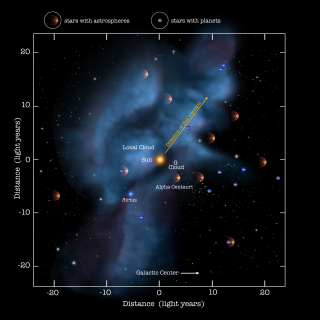 | | Due to the protective shielding of dangerous Galactic Cosmic Rays provided by a heliosphere or astrosphere, these structures are important for the planets that orbit the respective stars. Only over the last 15 years, we have been able to detect the first astrospheres and planets around other stars (exoplanets). Here we show a zoom into the most immediate environment around the Sun, our cosmic neighborhood. The locations of known astrospheres and exoplanets are indicated, while we anticipate that many more are present and just awaiting discovery. The nearest star, alpha Centauri has an astrosphere, and we know of at least two cases where we have detected both an astrosphere and exoplanets. These systems are truly analogous to our system in which the heliosphere shields a diverse planetary system. FULL IMAGE.Credit: NASA/Adler/U. Chicago/Wesleyan Available formats: 4184 x 4184 JPEG 2 MB 320 x 320 PNG 276 KB | |||||||||||||||||||||||||||||||||||||||
| | |||||||||||||||||||||||||||||||||||||||||
 | | The solar journey through space is carrying us through a cluster of very low density density interstellar clouds. Right now the Sun is inside of a cloud that is so tenuous that the interstellar gas detected by IBEX is as sparse as a handful of air stretched over a column that is hundreds of light years long. These clouds are identified by their motions. Labels.Credit: NASA/Adler/U. Chicago/Wesleyan Available formats: 4184 x 4184 JPEG 2 MB 320 x 320 PNG 268 KB | |||||||||||||||||||||||||||||||||||||||
| | |||||||||||||||||||||||||||||||||||||||||
 | | The solar journey through space is carrying us through a cluster of very low density density interstellar clouds. Right now the Sun is inside of a cloud that is so tenuous that the interstellar gas detected by IBEX is as sparse as a handful of air stretched over a column that is hundreds of light years long. These clouds are identified by their motions. No Labels.Credit: NASA/Adler/U. Chicago/Wesleyan Available formats: 4184 x 4184 JPEG 1 MB 320 x 320 PNG 247 KB 160 x 80 PNG 55 KB 80 x 40 PNG 25 KB | |||||||||||||||||||||||||||||||||||||||
| | |||||||||||||||||||||||||||||||||||||||||
 | | Collage of images shown in the press conference.Credit: NASA/GSFC/Hubble/SwRI/CI Lab Available formats: 1280 x 720 TIFF 2 MB 1280 x 720 JPEG 975 KB 320 x 180 PNG 299 KB | |||||||||||||||||||||||||||||||||||||||
| | |||||||||||||||||||||||||||||||||||||||||
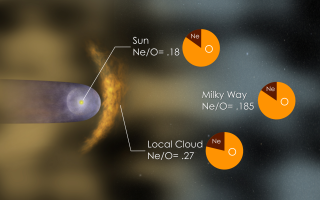 | | Alternate still showing the neon to oxygen ratio in the neutral gas of the local cloud, as obtained with IBEX, in comparison with the ratio for the Sun and the Milky Way galaxy. Available formats: 2300 x 1440 TIFF 9 MB 2300 x 1440 JPEG 1 MB 1150 x 720 JPEG 218 KB 320 x 200 PNG 352 KB | |||||||||||||||||||||||||||||||||||||||
| |||||||||||||||||||||||||||||||||||||||||
| Back to Top | |||||||||||||||||||||||||||||||||||||||||

lilian- Moderador Global

 Temas similares
Temas similares» Varios millones de planetas del tamaño de la Tierra en la Vía Láctea, según NASA
» El satélite Corot halla diez nuevos planetas fuera del Sistema Solar
» La NASA halla indicios de que la vida llegó la Tierra desde el espacio
» La NASA halla indicios de que la vida llegó la Tierra desde el espacio
» La NASA captura imágenes de un tornado solar del tamaño de la tierra
» El satélite Corot halla diez nuevos planetas fuera del Sistema Solar
» La NASA halla indicios de que la vida llegó la Tierra desde el espacio
» La NASA halla indicios de que la vida llegó la Tierra desde el espacio
» La NASA captura imágenes de un tornado solar del tamaño de la tierra
MUNDOALERTA . LAS NOTICIAS MAS DESTACADAS DEL MUNDO :: NOTICIAS RELACIONADAS CON EL COSMOS :: Actualidad de eventos exteriores a nuestro Sistema Solar. (Galaxia/s, Estrellas, ...)
Página 1 de 1.
Permisos de este foro:
No puedes responder a temas en este foro.|
|
|



